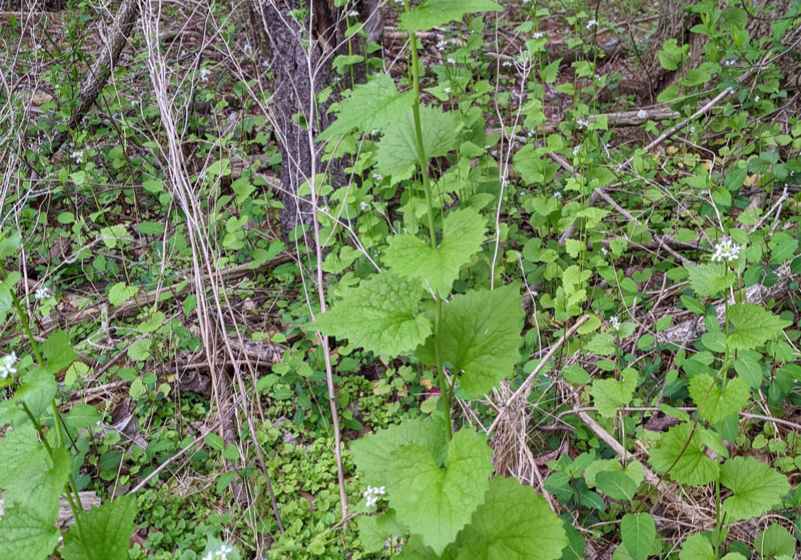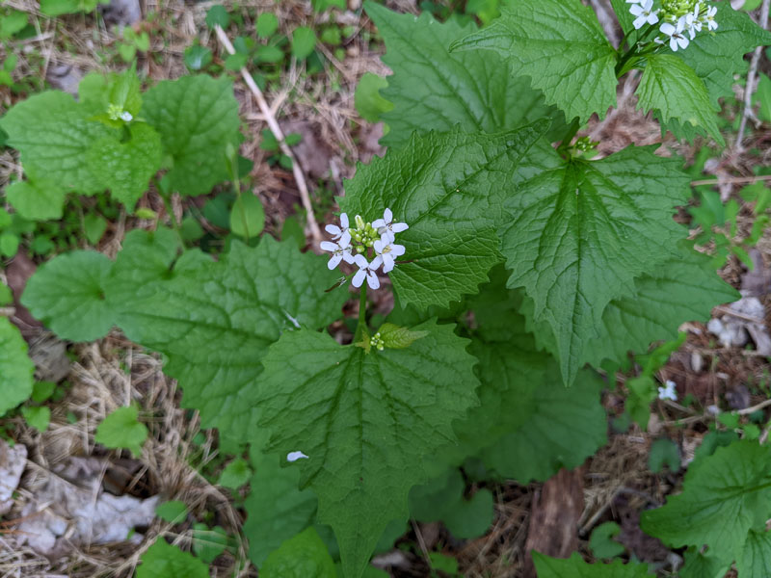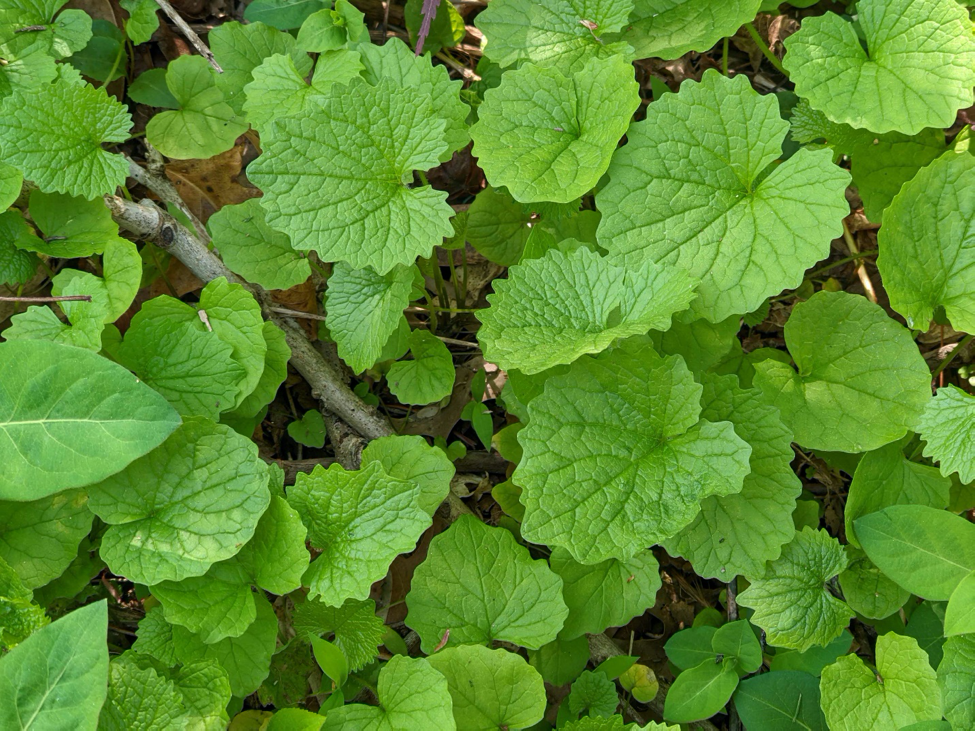There is a good chance you may have seen Garlic Mustard while walking along the trails in Liberty Reservoir, in your backyard, or growing in vacant lots. This plant is quite prolific and it spreads easily. The white flowers look pretty but don’t let that deceive you. Garlic Mustard is a destructive invasive that significantly impacts Liberty Reservoir’s understory.
Garlic Mustard appears within and around Liberty Reservoir this time of year. This invasive is an herbaceous member of the mustard family. It is a biennial plant, meaning that it fully matures in two years. Juvenile Garlic Mustard appears as rosettes that are close to the ground. In its second year mature Garlic Mustard becomes a 2-3 foot high plant with stalks of white flowers. Each flower contains four petals that form a cross. The taproot has a distinct S-curve just below the root crown, making it easy to pull out of the ground.
Garlic Mustard is a serious invasive in many states, including Maryland. This plant goes by many names including hedge garlic, sauce-alone, jack-in-the-bush, garlic root, garlic wort, and mustard root.
Garlic Mustard is an edible herb used for cooking. It was introduced into the United States from Europe and Asia in the 1860s for use as an herb and for medicinal purposes. Garlic Mustard was also used to control soil erosion.
The crushed leaves have a pungent garlic-like flavor. The root tastes like horseradish and the leaves are used for making sauces and salads. The seeds are thought to have some medicinal value. Some people still use Garlic Mustard for cooking but it is important to harvest young leaves; younger leaves are less bitter and older leaves contain cyanide that can be removed by thoroughly cooking the older leaves.

Juvenile Garlic Mustard appears as rosettes that are close to the ground. This picture was taken on the Green Trail in Liberty Reservoir.
(Photo by Phil Canter)
Recipes using Garlic Mustard can be found on the Internet such as:
https://www.co.wood.wi.us/Departments/LandConservation/Brochures/Garlic%20Mustard%20Recipes.pdf
Garlic mustard is highly nutritious with high amounts of Vitamin A, Vitamin C, fiber, and beta-carotene; as well as trace minerals, chlorophyll, Vitamin E, zinc, and enzymes (https://www.offthegridnews.com/off-grid-foods/garlic-mustard-the-super-nutritious-edible-weed-you-probably-mow-over/). For this reason, the leaves can be used as an ingredient for power drinks.

Garlic Mustard has a distinctive heart-shape leaf and stalks of white flowers. Each flower contains four petals that form a cross. This picture was taken on the Green Trail in Liberty Reservoir.
Photo by Phil Canter.
Garlic Mustard also grows and flowers before other native species emerge from the ground. It is unusual to find one or two plants of Garlic Mustard growing together; rather, because seeds spread easily it is not unusual to find 10 or 20 Garlic Mustard plants growing together in dense patches. The high concentration of Garlic Mustard plants reduces sunlight and out competes native species for vital moisture and nutrients.
Controlling Garlic Mustard
Fortunately, Garlic Mustard is one invasive that is relatively easy to remove and control. The preferred method for removing Garlic Mustard is simply to pull out the plant by the tap root.
Grab the plant close to the ground and pull it out. Be sure to pull out the root as well as the plant. It is important to pull out the plant before it goes to seed; otherwise, pulling the plant out will help scatter seeds for future plants. A good time to pull out Mustard Garlic is after it rains when it is easier to pull out the root.
Why is Garlic Mustard considered an “Invasive”?
Garlic Mustard spreads easily by seed. Each plant can produce thousands of mobile seeds that can be spread by wind and water. Seeds are sticky and tend to attach to animal fur, clothing, and shoes. The seeds easily germinate producing dense monocultures that crowd out native species. Seeds can remain viable in soil for up to five years. This five-year seed bank makes Garlic Mustard difficult, but not impossible, to control. You may notice that a group of Garlic Mustard plants has very little growing around it. This is because Garlic Mustard roots release chemicals that suppresses the growth of trees and other beneficial understory plants.

Garlic Mustard has a distinctive S-shape to its roots making it easy to pull out of the ground. Photo by Phil Canter.
Do not put pulled-out Mustard Garlic into a compost. Rather, put the plants into a black garbage bag, let it sit out in the sun for a day, and then throw it away in the garbage.
Also, be sure to check your clothes and shoes for seeds. Garlic Mustard seeds tend to stick to clothes and animal fur which helps to disperse the seeds.
This is the time to pull out Garlic Mustard, so if you see this plant, pull it out by the roots immediately before it goes to seed.

